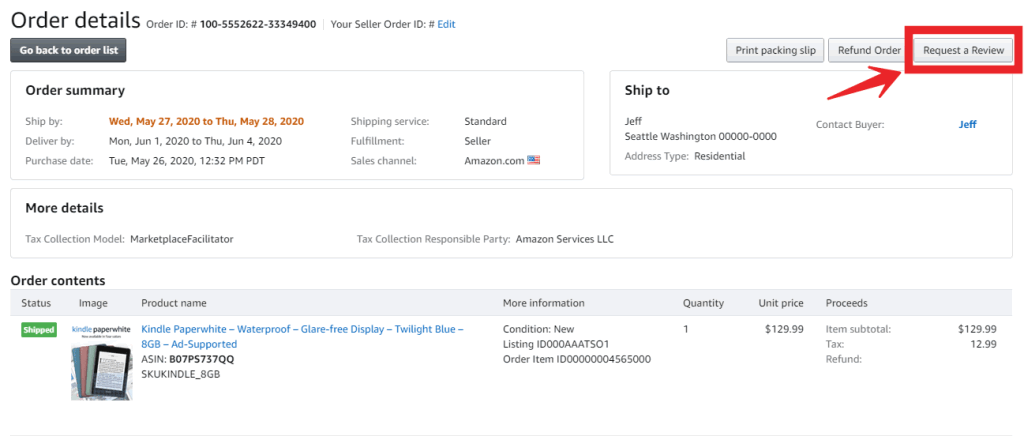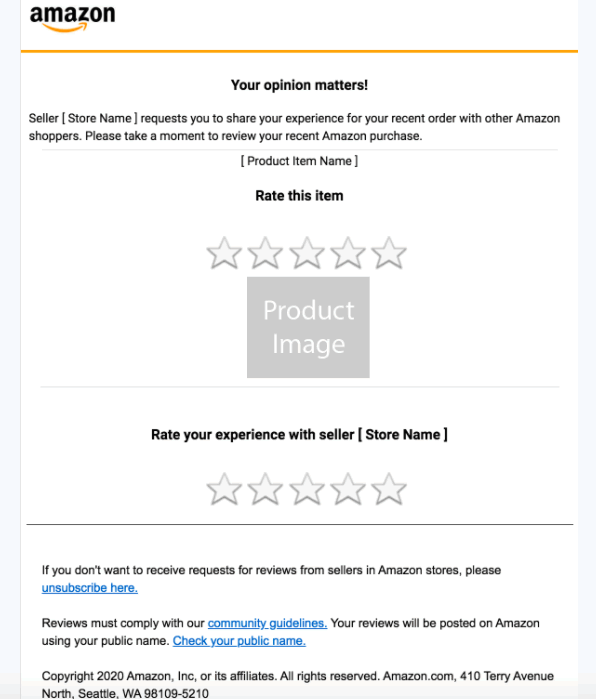This article is by Henson Wu of FeedbackWhiz.
It’s pretty clear that Amazon doesn’t really like sellers asking for reviews. Over the years, they have brought in more and more restrictions on how sellers can request reviews and the overall message is clear: we don’t really want you to do it.
Or so it seemed, until Amazon introduced its own “Request a Review” button which does exactly that – a couple of clicks and Amazon sends a message to the buyer asking for a review! It seems to run counter to everything they have been doing to date.
So, here’s everything you need to know about the Request a Review button. I cover how it works, why Amazon created it, the pros and cons of using it, and if you can still ask for reviews yourself.
| Do you have a great business idea, but you don’t know how to get started selling online? Helium 10. With Helium 10, you can find all the information needed to make data driven decisions. The platform is packed with features that help you find new customers, drive sales, and manage your day-to-day operations. So whether you’re just getting started or you’ve been in business for years, Helium 10 has everything you need to take your business to the next level. You can get 20% discount on Helium 10 with the following promo code: WEBRETAILR20 |

Get 20% discount on Helium 10 from us
How does Amazon’s “Request a Review” button work?
The “Request a Review” button can be found in Amazon Seller Central, on the details page for each buyer order. It is at the top right corner of the page, next to the button to send a refund.

Pressing the button triggers an email to the buyer, asking them to leave a product review or seller feedback. The message is sent directly from Amazon to the buyer. The seller does not have any way to customize the message, or any other control over the contents. Amazon does, however, automatically translate the text into the buyer’s language.
Review requests can only be sent between five and thirty days after the order is delivered, and you can’t send a second request for the same order. There is no option in the message to contact the seller or otherwise ask for help with the product or order.
In summary, the feature allows sellers to request reviews (and seller feedback) in a simple way that is fully compliant with Amazon’s complex policies around review solicitation.
| Build a thriving Amazon business today! Jungle Scout is the essential software that can help you win on Amazon and beyond. With Jungle Scout, you’ll have everything you need to make informed decisions about what products to sell on Amazon. You’ll be able to see exactly how well each product is selling, what the competition looks like, and how much profit you could potentially make. You can try Jungle Scout risk-free for 7 days. |

Try Jungle Scout risk-free for
7 days.
What does Amazon’s review request email look like?
The email comes directly from Amazon, so it is sent from an Amazon email address and has Amazon’s standard branding. The wording makes it clear, however, that it is being sent at the request of the seller.
The email includes:
- Seller name
- Product name
- Product image
- Stars to rate the product
- Stars to rate the seller
Here is an example, with placeholders for the various elements:

The product image provides a useful visual reminder for the buyer that this relates to a product that they purchased. The unfilled stars communicate that they are being asked to click them to provide a review.
Overall it’s a functional design that makes it very clear what is being requested, even without reading any of the text.
Why did Amazon create the “Request a Review” button?
Amazon has made a lot of changes over the years to how sellers can request reviews, and they have all been about restricting what sellers are allowed to do. The only exception to this is the Request a Review button. Other than that, Amazon has:
- Banned incentivized reviews
- Allowed buyers to opt-out of messages from sellers
- Tightened up policies so reviews can only be requested in a very specific way
- Introduced detailed rules on the way buyer-seller messaging can be used
These measures were not taken without good reason. Sellers (and other people working for them) have been abusing the system, writing fake reviews, and undermining consumer’s trust in Amazon. Amazon has sued over 1,000 sellers and reviewers who have indulged in review manipulation.
Amazon has restricted review solicitation so much, many sellers believe that they are not allowed to ask for reviews at all. So why introduce a feature that allows sellers to do exactly that?
Well, by providing their own feature to request reviews, Amazon is bringing the practice under their control. The button is easy to use and requests both product reviews and seller feedback. Sellers can choose when to use it, and which orders to use it on (you cannot ask for reviews only from buyers who had a positive experience, but selecting orders for other reasons is not mentioned in Amazon’s policies). This makes it appealing to sellers, while giving Amazon complete control over the contents of the message.
Do I have to click the button for one order at a time?
Yes you do. The button only appears on the order details page, so you have to navigate to each order before you can click the button. Then there is the prompt to ask if you are sure before the request is sent. Opening a page for every order, then clicking twice to actually send the request, creates a serious amount of work if you have a large daily order volume.
Switching to a tool which automates review requests through buyer-seller messaging is one alternative to this, and that also provides the opportunity to customize the message.
Another is a tool which, in effect, clicks the button for you to speed up the process. These are usually Chrome Browser extensions, which alter the interface in Amazon Seller Central. These are not approved or supported by Amazon and can be insecure and error-prone.
There is, however, a new Amazon API for automating review requests. This means that approved third-party tools can trigger the message in exactly the same way as the button, without you having to navigate to every order. This is the best option if you have a high order volume, and want to use the Request a Review feature rather than buyer-seller message. My tool FeedbackWhiz includes this feature as do others on the market.
Can I still request reviews through buyer-seller messaging?
You can still request reviews through buyer-seller messaging. As mentioned before, there are restrictions (such as not asking specifically for a positive review), but it is still allowed.
Buyer-seller messaging allows sellers to fully personalize their review requests, customize the subject line and content, insert a logo and attach files. You must be aware of the review policies and communication guidelines otherwise it’s very easy to get slapped with a restriction. Also make sure you are aware of the policy changes announced in September 2020.
There are software tools on the market (like my app FeedbackWhiz) which can provide automation for buyer-seller messaging emails and the Request a Review button. This means you create a process for requesting reviews, configured to run when and how you want, and let it run on autopilot instead of manually sending messages.
One final point is that when using the Request a Review button, Amazon shows a message which says two things that may come across as a little odd:
- It hints that you shouldn’t request a review at all, even though you just clicked a button created to do exactly that.
- It asks politely that you use the button to request a review, instead of buyer-seller messaging, if you really do want to request a review!
Here’s how it looks, with bold added to highlight those points:
Request a Review
We don’t require you to request reviews because our systems already do that at no cost to you. However, if you prefer to request a review for this order, please use this feature instead of asking the customer via email or buyer-seller messaging.
When you use this feature, we will send the customer an email requesting product and seller reviews for this order. We automatically translate review requests to the customer’s preferred language.
Are you sure you want to request a review for this order?
It’s easy to see why many sellers believe that they are not allowed to request a review through buyer-seller messaging. However, Amazon’s Q&A on product reviews, as well as the policy changes in September 2020, make it clear that you can still ask for reviews this way.
Is it OK to send my own review requests as well as using the button?
No, you cannot use the Request a Review button and also ask for a review via buyer-seller messaging for the same order.
Amazon’s communication policy states that you are only allowed to request a review once per order, and that applies regardless of which method you use. If you use both methods to request a review for the same order, Amazon might put a 30-day proactive buyer-seller messaging restriction on your account.
However, some sellers have products that require communication with the buyer to complete the order, for example to ask for custom design information. In this case, they can use buyer-seller messaging to ask for the details they need (but not ask for a review) and use the Request a Review button later, within the standard 5-30 days window after delivery.
What are the benefits of using the “Request a Review” button?
There are some useful benefits to using the button to request reviews:
- It is 100% compliant with Amazon’s terms of service, so you should never be penalized for using it and don’t have to worry about how to word your message.
- Messages are automatically translated into the buyers preferred language.
- The product name and image are included in the message.
- It is separate from buyer-seller messaging, so you can use it even if you have been restricted from sending proactive messages.
- It only allows you to trigger it once and won’t send a request if a buyer has already left a review.
- You can choose when to send the request, and which orders to send it for.
Overall, the button is convenient, simple and risk-free.
Are there any limitations to using the button?
The button is a simple tool, so there are several limitations to consider:
- No tracking of open or conversion rates.
- You can’t personalize the subject line or body content.
- Requests can only be sent 5 to 30 days after the order was delivered.
- Buyers cannot reply to the email, for example if they have questions or issues.
- You have to click the button for one order at a time.
Perhaps the biggest drawback is that buyers who are having difficulty with the product might be further frustrated by being asked for a review, with no other options given. That can lead to a knee-jerk reaction of clicking the stars to leave negative feedback.
If you use buyer-seller messaging to ask for reviews, you can tell the buyer how to get help with the product, which gives you an opportunity to deal with any issues they are having. Resolving problems for buyers by providing support is by far preferable to receiving a negative review.
This article was by Henson Wu of FeedbackWhiz, a tool for Amazon sellers which helps repair seller feedback, improve product reviews and automate high-volume emails.

"""It only allows you to trigger it once and won’t send a request if a buyer has already left a review.""" How do you know this? Is this documented somewhere?
FYI here is Amazon's (short) help page on the button: https://sellercentral.amazon.com/gp/help/external/698QJEQJZFEXSAT
The author is an expert on Amazon's feedback system - his business provides software that interacts with it both via the Request a Review button and Buyer-Seller Messaging. I'll leave it to him to comment further if he has something to add.
Is your experience of using the button different?
Thanks for the link. I guess you provided it to show me general info about the "Request a review" feature. I'm looking more for official Amazon documentation (proof) that if someone has already left a review, and you request a review, Amazon won't send a second request. I know me asking probably sounded very "toney". It was genuinely an innocent, non-snarky question though. I'm just looking to confirm this is true. I want to believe it. Also, I was wondering, if a customer had left a review, and they place a second order in a month, if I click the "Request a review" button on their second order one month later, does the system let me SEND a request? Or does it say something like "This buyer has already left a review" or something even more generic, thereby, not letting me send a request at all?
No problem at all Jarad, ask away. I provided the link because I think it addresses the first part of your question: "It only allows you to trigger it once". The Amazon page says "You can use this feature to request reviews once per order".
Granted, it's just an Amazon help page rather than a technical spec, and the help pages are sometimes wrong or ambiguous, so maybe it's not the definitive answer on that point that you are looking for.
Or you can look at the API documentation (actually linked from the article) here: https://github.com/amzn/selling-partner-api-docs/blob/main/references/solicitations-api/solicitations.md#createproductreviewandsellerfeedbacksolicitation
This says "Send only one productReviewAndSellerFeedback or free form proactive message per order."
TBH I'm not sure you will find a more detailed answer officially documented by Amazon. It's the kind of thing that developers will test, and that testing will quickly tell them how the system responds to the different situations you describe.
Understood. I'm a developer myself so I completely relate to your "how the system responds" comment. Thanks for the discussion on this. It did definitively answer the nagging "once per order" question I had. Seems like that's a non-optimal business decision by Amazon. If repeat customers get a request to review a product they re-order occasionally, that would be annoying - especially if they already left a review in the past. At one point, I kept track of who I sent Request for reviews on a per-customer basis based on their order history, but it's just gotten to be too time-consuming to track at this point. The Amazon system should really handle the potential risk of annoyance. Anyways, thanks again.
Hi Jarad, Yes we know because these are the specs provided by Amazon. Also, as a seller, you can verify this for orders that you have triggered previously. When you try to re-trigger, you will get a message saying that it has already been triggered.